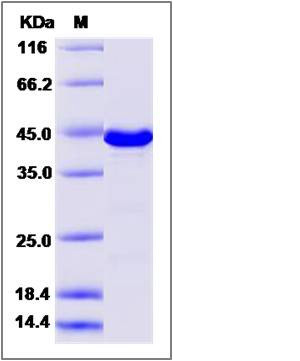Human ERK3 / MAPK12 / P38-gamma Protein
ERK-6,ERK3,ERK6,MAPK12,P38GAMMA,PRKM12,SAPK-3,SAPK3
- 100ug (NPP3849) Please inquiry
| Catalog Number | P15676-HNCB |
|---|---|
| Organism Species | Human |
| Host | Baculovirus-Insect Cells |
| Synonyms | ERK-6,ERK3,ERK6,MAPK12,P38GAMMA,PRKM12,SAPK-3,SAPK3 |
| Molecular Weight | The recombinant human MAPK12 consists of 369 amino acids and has a calculated molecular mass of 42.1 kDa. The recombinant protein migrates as an approximately 43 kDa band in SDS-PAGE under reducing conditions. |
| predicted N | Gly |
| SDS-PAGE |  |
| Purity | > 95 % as determined by SDS-PAGE |
| Protein Construction | A DNA sequence encoding the human MAPK12 (P53778) (Met1-Leu367) was fused with two additional amino acids (Gly & Pro) at the N-terminus. |
| Bio-activity | Kinase activity untested |
| Research Area | Immunology |Inflammation / Inflammatory Mediator |Pattern Recognition Receptors |NOD-like Receptors and the Inflammasome |
| Formulation | Supplied as sterile 20mM Tris, 500mM NaCl, 10% glycerol, pH 8.0. 1. Normally 5 % - 8 % trehalose and mannitol are added as protectants before lyophilization. Specific concentrations are included in the hardcopy of COA. |
| Background | ERK3, also known as MAPK12 and p38-gamma, belongs to the protein kinase superfamily, CMGC Ser/Thr protein kinase family and MAP kinase subfamily. ERK3 is highly expressed in skeletal muscle and heart. ERK3 is a serine/threonine kinase which acts as an essential component of the MAP kinase signal transduction pathway. MAPK12 is one of the four p38 MAPKs which play an important role in the cascades of cellular responses evoked by extracellular stimuli such as proinflammatory cytokines or physical stress leading to direct activation of transcription factors such as ELK1 and ATF2. Accordingly, p38 MAPKs phosphorylate a broad range of proteins and it has been estimated that they may have approximately 200 to 300 substrates each. MAPK12 is required for the normal kinetochore localization of PLK1, prevents chromosomal instability and supports mitotic cell viability. MAPK12-signaling is also positively regulating the expansion of transient amplifying myogenic precursor cells during muscle growth and regeneration. |
| Reference |
